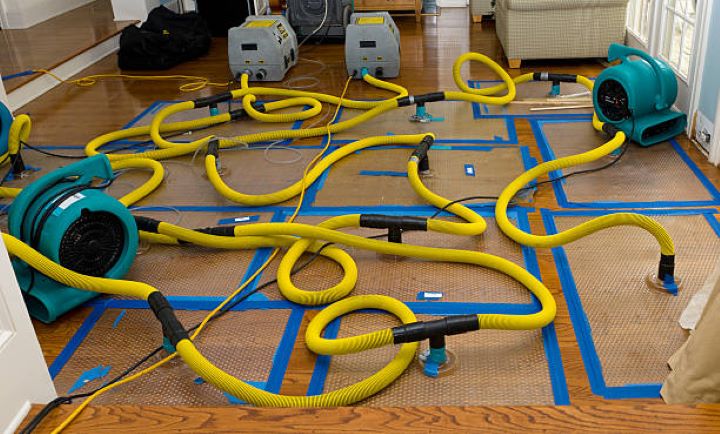Water damage can have devastating consequences for both homes and businesses. It can result in structural issues, mold growth, water contamination, and more. That’s why water damage mitigation is of utmost importance.
The process of water damage mitigation involves taking proactive steps before, during, and after an incident to minimize the risk of further damage and restore the property to its original condition.
This comprehensive guide delves into the intricacies of water leak mitigation and water damage mitigation, providing detailed insights. We will address key questions such as the definition of water mitigation, its significance, the steps involved, and how to create an effective water damage mitigation plan.
Discover everything you need to know about water mitigation plans, processes, and how they can safeguard your property from the perils of water damage.
Water Mitigation Definition: What Is It?
Water leak mitigation, also known as water damage mitigation, involves a series of steps aimed at reducing water damage and associated losses.
These steps encompass various measures such as reducing water content in affected materials, controlling humidity levels, and addressing water infiltration.
The primary objective of water mitigation is to minimize water damage and swiftly restore the property to its original condition.
By implementing effective water mitigation practices and following well-crafted water mitigation plans, you can not only prevent further water damage but also safeguard your property against future water infiltration.
What Causes Water Damage?
Water damage can occur due to various factors, such as:
- Le pipes and plumbing fixtures
- Natural disasters like storms or hurricanes
- Sewer backups or overflows
- Failures in fire sprinkler systems
- Roof leaks and structural damage
- Frozen pipes
- Faulty water supply lines
- Excessive debris in the drainage system
These issues can potentially lead to water damage and should be addressed promptly to prevent further complications.
Mitigation For Water Damage: How Many Types Are There?
There are 3 types of mitigation for water damage, depending on the level of the water damage. Let’s explore them one by one.
1. Clean Water Damage Mitigation Process
In cases of minimal water damage, the mitigation process entails the removal of any standing water and comprehensive cleaning.
This involves vacuuming carpets and upholstery, wiping down walls and shelves, and sanitizing all affected materials.
Once everything is clean and thoroughly dried, a careful assessment of the damage can be made to determine if additional mitigation measures are necessary.
2. Grey Water Damage Mitigation Process
In the event of water contamination, effective mitigation requires the complete removal of affected materials and thorough cleaning of any remaining surfaces.
Moreover, it may be necessary to utilize specialized solutions and equipment to disinfect and deodorize the area, ensuring comprehensive mitigation.
3. Black Water Damage Mitigation Process
If the water is severely contaminated, proper mitigation requires the complete removal of affected materials, followed by meticulous cleaning and sanitization of the area.
Additionally, it may be necessary to engage a professional mitigation company to provide supplementary services such as mold remediation or structural repairs. They can also provide an accurate estimate for the mitigation process.
Professional Mitigation For Water Damage: Water Mitigation Steps
To ensure a successful mitigation process, there are certain steps that must be followed. Here are the steps for water mitigation:
Step 1: Find The Source
To begin, it is crucial to identify the origin of the water damage. This entails inspecting the area and determining the root cause of the initial water infiltration.
Pay attention to any indications of leaking pipes, clogged drains, or structural impairment that could potentially be the source of the water infiltration.
Once you have successfully located the source, it is time to take decisive measures to mitigate the water damage. This may involve shutting off the water supply line or conducting necessary repairs to rectify any damaged pipes.
Step 2: Remove Standing Water
After identifying and stopping the source of water infiltration, the next step is to eliminate any remaining standing water. This typically involves a combination of vacuuming and using specialized drying equipment to absorb the water. Professional technicians skilled in water damage mitigation utilize advanced technology and tools to promptly and safely remove all standing water.
Step 3: Assess The Water Damage
The next step in water mitigation is to assess the extent of the water damage and determine the necessary actions to prevent further harm.
This may involve removing any damaged materials, applying specific solutions, or utilizing specialized equipment to properly dry the affected area.
Your mitigation specialist will thoroughly evaluate the damage and provide recommendations on the most suitable course of action.
Step 4: Set Equipment Up
After the assessment is finished, your mitigation specialist will arrange their equipment to initiate the drying process.
This may include utilizing air movers, dehumidifiers, as well as specialized drying solutions and tools.
The intensity and effectiveness of these equipment pieces will vary based on the extent of the water damage.
Step 5: The Dry Out
After the equipment is set up, the drying process can commence, marking the crucial stage that initiates water damage restoration.
Typically, drying out a property necessitates multiple days and constant monitoring to ensure thorough drying of all affected materials.
Your mitigation specialist will make necessary adjustments to the equipment for an effective dry-out. Once the drying process is complete, the repair phase
Step 6: Comparison
Maintaining visual evidence, such as photographs, of the property before and after the mitigation process is crucial. This allows for a clear comparison of the property’s condition, both prior to and after the mitigation took place.
In addition to its significance in insurance claims, this evidence serves as proof of water damage in the property and its proper mitigation.
Step 7: Water Damage Restoration
Water damage restoration is the crucial final step in the water mitigation process. It encompasses the repair or replacement of materials and the thorough resolution of any structural damage.
Equally important is the meticulous cleaning and disinfection of the area once restoration is complete. This meticulousness guarantees the absence of bacteria, mold, or other contaminants in the vicinity following the completion of the mitigation process.
How To Create A Water Damage Mitigation Plan?
Water damage can pose significant financial and time-related challenges, but it needn’t be an insurmountable issue.
By formulating a comprehensive water mitigation plan, homeowners and business owners can proactively mitigate the risk of water damage to their properties.
An effective water mitigation plan encompasses all essential steps for evaluating potential sources of water infiltration, safely removing standing water, assessing the extent of damage, correctly installing drying equipment, thoroughly drying affected areas, and restoring any compromised materials.
With meticulous planning and execution, a successful water mitigation process can help minimize losses resulting from flooding or other water-related incidents. Here’s a breakdown of the key actions to take when developing an effective water mitigation plan:
- Identify the source of water infiltration.
- Install equipment and initiate the drying process.
- Continuously monitor progress throughout the drying phase.
- Remove any damaged materials.
- Utilize specialized solutions or equipment to effectively dry the area.
- Document “before” and “after” images of the property to assess the impact.
- Repair or replace any materials that have been compromised.
- Thoroughly clean and disinfect the area to prevent the growth of bacteria, mold, or other contaminants.
- Ensure that any structural damage is adequately addressed.
- Develop a plan for future prevention, if necessary.
By following these steps, individuals can safeguard their properties and minimize the potential negative consequences of water damage.
Water Damage Mitigation Plan: Why Is It Necessary?
Water damage is a significant issue that requires prompt and accurate attention. It may create a bad effect on interior design. Unsecured water sources like broken pipes, sewer backups, or leaks can cause extensive property damage.
That’s why it’s crucial to have a water mitigation plan in place before encountering water damage. This ensures a quick and appropriate response.
A water mitigation plan outlines the necessary steps to assess, remove water, dry affected areas, repair or replace damaged materials, and restore the property to its pre-flood condition.
Additionally, it provides guidance on comparing before-and-after pictures of affected areas and thoroughly cleaning and disinfecting them after repairs.
A water mitigation plan is an essential component of preventing water damage. It efficiently and effectively reduces water-related losses by promptly addressing water damage incidents.
How Much Does Water Mitigation Cost?
The cost of water mitigation can vary based on several factors, including the extent and type of damage, the duration of the process, and the level of restoration required.
Typically, the estimates for mitigation can range from a few hundred to several thousand dollars, depending on the severity of the water damage. Here in Florida, the average cost of water mitigation services is approximately $2,500.
To get an accurate estimation, it is advisable to contact a local water mitigation specialist who can assess the damage and provide a detailed estimate tailored to your specific needs.
Furthermore, it is worth noting that certain insurance plans may cover some or all of the expenses associated with water mitigation. Before proceeding, it is recommended to reach out to your insurance provider to determine if your situation qualifies for any coverage.
Conclusion
Water damage can cause devastating damage in homes and businesses if not taken care of immediately. It is essential to have a water mitigation plan in place to effectively address any water-related issues quickly and efficiently. The cost of the mitigation will depend on several factors, but it is recommended to contact a local specialist for an accurate estimation tailored to your needs. Remember to check with your insurance provider to determine if any coverage is available for the costs associated with the water mitigation process. By taking the proper steps, you can help protect your property from the harmful effects of water damage and ensure a successful restoration process.



